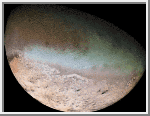
Neptune I
Triton [TRY-tun] is the largest moon of Neptune, with a diameter of 2,700 kilometers (1,680 miles). It was discovered by William Lassell, a British astronomer, on October 10, 1846 scarcely a month after Neptune was discovered. Triton is colder than any other measured object in the Solar System with a surface temperature of -235° C (-391° F). It has an extremely thin atmosphere. Nitrogen ice particles might form thin clouds a few kilometers above the surface. The atmospheric pressure at Triton's surface is about 15 microbars, 0.000015 times the sea-level surface pressure on Earth.
Triton is the only large satellite in the solar system to circle a planet in a retrograde direction -- in a direction opposite to the rotation of the planet. It also has a density of about 2.066 grams per cubic centimeter (the density of water is 1.0 gram per cubic centimeter). This means Triton contains more rock in its interior than the icy satellites of Saturn and Uranus do. The relatively high density and the retrograde orbit has led some scientists to suggest that Triton may have been captured by Neptune as it traveled through space several billion years ago. If that is the case, tidal heating could have melted Triton in its originally eccentric orbit, and the satellite might even have been liquid for as long as one billion years after its capture by Neptune.
Triton is scarred by enormous cracks. Voyager 2 images showed active geyser-like eruptions spewing nitrogen gas and dark dust particles several kilometers into the atmosphere.
| Triton Statistics | |
|---|---|
| Discovered by | William Lassell |
| Date of discovery | 1846 |
| Mass (kg) | 2.14e+22 |
| Mass (Earth = 1) | 3.5810e-03 |
| Equatorial radius (km) | 1,350 |
| Equatorial radius (Earth = 1) | 2.1167e-01 |
| Mean density (gm/cm^3) | 2.07 |
| Mean distance from Neptune (km) | 354,800 |
| Rotational period (days) | -5.87685 |
| Orbital period (days) | -5.87685 |
| Mean orbital velocity (km/sec) | -4.39 |
| Orbital eccentricity | 0.0000 |
| Orbital inclination (degrees) | 157.35 |
| Escape velocity (km/sec) | 1.45 |
| Visual geometric albedo | 0.7 |
| Magnitude (Vo) | 13.47 |
| Mean surface temperature | -235°C |
See also: The Triton Map Images.
 Triton
Triton
Voyager 2
obtained this color image of Neptune's
large satellite Triton during its close flyby on Aug. 25, 1989.
The large south polar cap at the bottom of the image is
highly reflective and slightly pink in color; it might consist of a
slowly evaporating layer of nitrogen ice deposited during the
previous winter. From the ragged edge of the polar cap northward,
the satellite's face is generally darker and redder in color.
This coloring may be produced by the action of ultraviolet light
and magnetospheric radiation
upon methane in the atmosphere and
surface. Running across this darker region, approximately
parallel to the edge of the polar cap, is a band of brighter
white material that is almost bluish in color. The underlying
topography in this bright band is similar; however, to that in the
darker, redder regions surrounding it.
(Courtesy NASA/JPL)
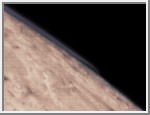 Tenuous Clouds on Triton
Tenuous Clouds on Triton
This image of Triton shows a thin cloud layer along the limb of the moon. The
image was obtained as
Voyager 2 swept past Triton at a speed of 27 kilometers per second and passed
within 39,800 kilometers. Voyager discovered that Triton possessed a thin atmosphere
of 15 microbars or 0.000015 times the surface pressure on Earth at sea level.
The limb of Triton also showed a thin haze about 13 kilometers from the surface
of the planet and thin patches of clouds as shown by this image.
(Copyright by Calvin J. Hamilton)
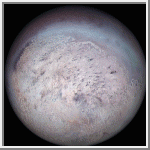 Triton
Triton
This picture is a global orthographic view of Triton centered at
-40° latitude and 0° longitude. It was created from
images obtained by the Voyager 2 spacecraft.
(Courtesy A. Tayfun Oner)
 Triton From The Hubble Space Telescope
Triton From The Hubble Space Telescope
This image of Triton was taken by the Hubble Space Telescope's
Faint Object Camera in September of 1995. It was created from a
blue and ultraviolet image. The color is false but closely matches
the color observed from voyager images.
Triton appears to be roughly 10% darker than in images taken by the
Voyager 2 spacecraft.
Also note that the equatorial region is bright, but there is a
darker region around the pole. With Triton's long seasons, the southern summer
has been progressing, and the south pole has received increasing sunlight;
thus, it is probable that much of the frost covering the region in 1989 has
evaporated, some of which may have condensed at the equator (hence the
bright region there). This image truly pushes the limit of HST's
resolving power. The image is centered at roughly 215 degrees latitude.
(Courtesy of Ted Stryk)
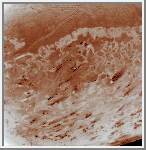 South Pole of Triton
South Pole of Triton
This high resolution image of Triton was obtained by Voyager 2
on August 25, 1989. It shows the moon's south polar cap. One
of the unusual aspect of this image is the dark streaks in the
images. Perhaps they were made by geyser-like eruptions of
nitrogen. The geyser eruptions could have carried darker
materials from the crust. The light regions probably consist
of layers of nitrogen.
(Credit: Calvin J. Hamilton)
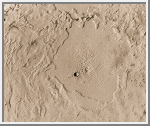 Plain of Ice
Plain of Ice
This view of Triton shows a plain of ice. It was probably formed by
eruptions of water or a water-ammonia slurry. It seems to fill the
remains of an ancient impact basin.
(Credit: Calvin J. Hamilton)
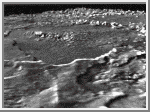 Triton in 3D
Triton in 3D
This is a computer-generated perspective rendering of one of
the caldera-like
depressions on Triton, as it would appear if
viewed from the northeast. The image was obtained
Aug. 24, 1989, when the Voyager spacecraft was about
181,800 kilometers
(112,900 miles) from Triton.
The caldera floor shown in this image is approximately
200 kilometers (120 miles) in
diameter. It is extremely flat and probably was formed by the
volcanic eruption of ice lavas of very low viscosity. The
bench visible in the foreground may be a remnant of earlier
flooding to a level about 200 meters (600 feet) higher than
the present caldera floor.
(Courtesy NASA/JPL)
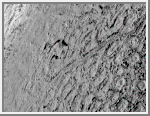 Surface of Triton
Surface of Triton
This is one of the most detailed views of the surface
of Triton taken by Voyager 2 on its flyby of the large satellite of
Neptune early in the morning of August 25, 1989. The picture was taken from a distance
of 40,000 kilometers (25,000 miles), the frame is about 220 kilometers (140
miles) across and shows details as small as 750 meters (0.5 miles). Most
of the area is covered by a peculiar landscape of roughly circular
depressions separated by rugged ridges. This type of terrain, which covers
large tracts of Triton's northern hemisphere, is unlike anything seen
elsewhere in the solar system. The depressions are probably not impact
craters: They are too similar in size and too regularly spaced. Their
origin is still unknown, but may involve local melting and collapse of the
icy surface. A conspicuous set of grooves and ridges cuts across the
landscape, indicating fracturing and deformation of Triton's surface. The
rarity of impact craters suggests a young surface by solarsystem
standards, probably less than a few billion years old.
(Courtesy NASA/JPL)
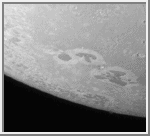 Dark Areas on Triton
Dark Areas on Triton
Voyager 2 acquired this black and white image of
Triton during the night of August 24-25, 1989.
Triton's limb cuts obliquely across the middle of the image. The field of
view is about 1,000 km (600 miles) across. Three irregular dark areas,
surrounded by brighter material, dominate the image. Low-lying material
with intermediate albedo occupies the central area, and fresh craters
occur along the right margin. Sub-parallel alignment of linear patches of
dark material shown in the lower and left part of the image suggests that
the patches are structurally controlled.
(Courtesy NASA/JPL)
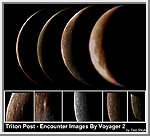 Post Encounter Images of Triton
Post Encounter Images of Triton
This set of images shows the best views of Neptune's moon Triton
taken by Voyager 2 as the spacecraft withdrew from the Neptune system on
August 25, 1989. The top four images were constructed from various color
image bands as Voyager receded from Triton.
(Courtesy Ted Stryk)
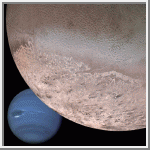 Montage of Neptune and Triton
Montage of Neptune and Triton
This computer generated montage shows Neptune as it
would appear from a spacecraft approaching Triton.
The wind- and sublimation-eroded south
polar cap of Triton is shown at the bottom of the Triton image, a
cryovolcanic terrain at the upper right, and the enigmatic cantaloupe
terrain at the upper left. Triton's surface is mostly covered by nitrogen
frost mixed with traces of condensed methane, carbon dioxide, and carbon
monoxide. The tenuous atmosphere of Triton, though only about one-hundredth
of one percent of Earth's atmospheric density at the surface, is
thick enough to produce wind-deposited streaks of dark and bright
materials of unknown composition in the south polar cap region. The
southern polar cap was sublimating at the time of the Voyager 2 flyby, as
indicated by the irregular and eroded appearance of the edge of the cap.
The polar frosts were sublimating because Triton's orbital and rotational
motion causes the sun to shine directly on the polar cap for a period of
several decades during Neptune's and Triton's long austral summer. Though
the polar cap was undergoing heat death, surface temperatures still were
only about 38 K (-391 degrees Farenheit).
(Courtesy NASA/JPL)
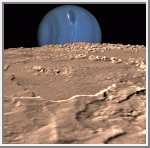 Neptune on Triton's Horizon
Neptune on Triton's Horizon
Composite view showing Neptune on Triton's horizon.
Neptune's south pole is to the left; clearly visible in the planets'
southern hemisphere is a Great Dark Spot, a large anticyclonic storm
system located about 20 degrees South. The foreground is a computer
generated view of Triton's maria as they would appear from a point
approximately 45 km above the surface. The terraces visible in this image
indicate multiple episodes of 'cryovolcanic' flooding. This three-dimensional
view was created from a Voyager image by using a two-dimensional
photoclinometric model. Relief has been exaggerated roughly
30-fold, the actual range of the relief is about 1 km. Would Neptune
appear to be rising or setting? Neither, due to the motion of Triton
relative to Neptune, it would appear to move laterally along the horizon,
eventually rising and setting at high latitudes.
(Courtesy NASA/JPL)

 Neptune
Neptune Proteus
Proteus Nereid
Nereid